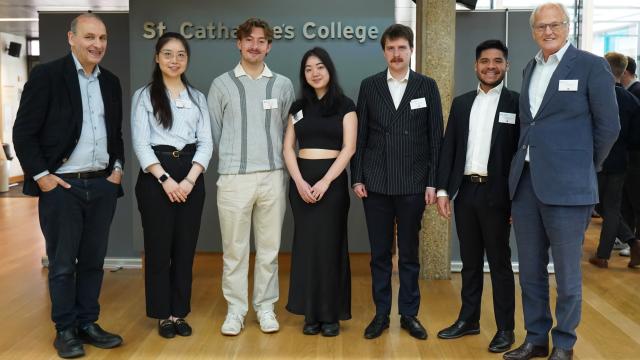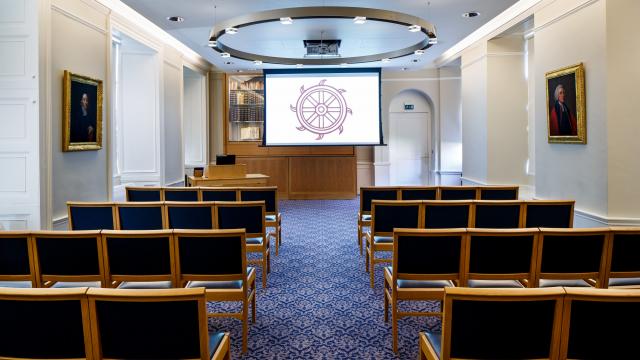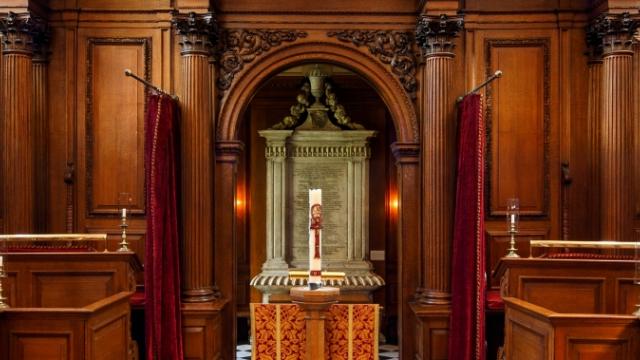
The following article has been published as part of a series celebrating 550 years since St Catharine’s was founded in 1473.
The St Catharine’s College community isn’t alone in celebrating a 550th anniversary this year. For astronomers, 2023 marks 550 years since the birth of Nicolaus Copernicus. Born on 19 February 1473, he went on to publish a model of the known Universe with the Sun at its centre, challenging the geocentric system that had been widely accepted since ancient times.
Dr Sophie Koudmani (2021) is the Bowring Junior Research Fellow at St Catharine’s. Her research aims to unravel the processes governing galaxy formation, especially the interface between galaxies and black holes. We caught up with Dr Koudmani about the circumstances of Copernicus’ important work and the advances in our understanding of the Universe that have been achieved by successive generations of astronomers since 1473.
Copernicus made his observations of planets and stars with the naked eye. How important have advances in methods like telescopy been to Astronomy?
“The importance of observations and advances in instrumentation that enable these cannot be overstated. In Astronomy, we can’t experiment with stars so observations are all we have to make inferences, test our ideas and differentiate between competing models. All observations were with the naked eye until the invention of optical telescopes in the Netherlands. Galileo Galilei made significant improvements to these early designs and presented his own telescope in 1609 which he then went on to use to observe moons orbiting Jupiter for the first time.
“Telescopes have become increasingly important for gathering observations. One telescope that’s been particularly important to my own work is the Sloan Foundation Telescope at the Apache Point Observatory in New Mexico in the USA, which has enabled the Sloan Digital Sky Survey (SDSS) – one of the largest surveys in the history of Astronomy – to use multi-spectral imaging and spectroscopy to create 3D maps of more than 930,000 galaxies. The SDSS started picking up hundreds of dwarf galaxies with black holes, but the theory about black holes ignored them, so my PhD at Cambridge’s Institute of Astronomy proposed a theoretical model for black holes in dwarf galaxies, and how these black holes and dwarf galaxies coevolve and influence the other’s development. This is a great example of how theorists like me can be inspired by observations made by telescopes.
“It’s exciting to think that our ability to observe astronomical objects is only going to get better thanks to the latest generation of telescopes launched into outer space. The Hubble Space Telescope launched in 1990 is perhaps one of the best known but we can now view objects too old, distant or faint for the Hubble after the James Webb Space Telescope was launched on Christmas Day 2021 (shortly after I joined Catz). This new space telescope will enable us to observe objects billions of light years away, which is exciting not just because of their distance but the light travel time effect means that we will be observing these galaxies as they existed billions of years ago.”
Once Copernicus’ heliocentric theory was published it took decades to gather substantial evidence and gain wider acceptance. Can this still happen today?
“The time lag after Copernicus published his model in 1543 is particularly extreme but there have been lots of examples since when it has taken a while to gather evidence to validate an astronomical theory. The Big Bang Theory competed for years with the Steady-State Theory until the 1960s when cosmic microwave background radiation was discovered. Other instances include dark matter (first proposed in the 1930s but it took decades until there was convincing evidence from astronomers like Vera Rubin) and black holes (Schwarzschild’s solution to Einstein’s general relativity for a black hole was in 1916 but there was doubt whether they could even exist until the first observational hints were recorded in the 1960s).
“The interplay between observation and theory in Astronomy is fascinating. We need observations to falsify or confirm theories, and use theory to interpret observations and explain why objects move in a certain way, such as the weird retrograde movement of planets that doesn’t make sense if the Earth were at the centre of the Solar System. Unfortunately for Copernicus, he had a decent theory but his predictions didn’t perform any better than the existing geocentric model because he assumed the planets had circular orbits. His theory was only vindicated once astronomers had access to better observations through improved instruments of measurement and the invention of telescopes, when Johannes Kepler realised (by analysing an extremely detailed data set collected by Tycho Brahe) that the planets move on elliptical orbits and Galileo’s discovery of the moons orbiting Jupiter (in strict contradiction to the geocentric theory that all heavenly bodies should circle the Earth).”
Copernicus was reportedly reluctant to publish his heliocentric theory. How do you approach communicating your research?
“I feel strongly that open communication of research is essential for scientific progress: if more people have access to findings, the original research team will get better feedback and new knowledge can be shared more widely. Nowadays it is very common to share astronomical papers on preprint servers, even ahead of acceptance by a peer-reviewed journal, which is a hugely valuable way to get early feedback from the wider research community.
“I’m pleased that the University of Cambridge and its Institute of Astronomy provide support for researchers like me who want to publish articles through open access journals so our findings can be read for free by anyone around the world. This is also important to me because taxpayers fund scientific research and the outcome of this investment needs to be available to everyone.
“Of course, the society in which I’m conducting research is very different to when Copernicus was alive. In all the countries I’ve lived (Germany, the UK and the USA), we now have protections for freedom of speech and can communicate our ideas without censorship. I consider myself lucky that I am free to explore the Universe and make sense of our place in it because Astronomy is no longer considered a controversial topic or a threat to the status quo.”
Copernicus was a mathematician as well as an astronomer. 550 years on, how important is maths in modern Astronomy?
“It is an exciting time in Astronomy: while maths and physics remain at the discipline’s core, there are also interfaces with other subjects like biology (through astrobiology’s search for the cradle of life), earth sciences (in the hunt for exoplanets) and computer sciences. Maths still provides the toolkit or language that we use for our astronomical models. Modern simulations relying on the laws of gravity and hydrodynamics essentially boil down to solving differential equations. Coding is becoming more and more important too: based on maths and statistics, we can code up numerical recipes to solve equations and analyse incredibly large data sets, such as populations of galaxies.”
Copernicus enjoyed an international academic career, with periods spent at the Universities of Krakow, Bologna, Padua and Ferrara. What role does international scientific exchange play in Astronomy today?
“International scientific exchange is absolutely crucial in Astronomy and science more generally. The ambitions of Astronomy are now so massive that it is not possible for a single institution or even country to pursue them unilaterally – we’re dealing with complex problems, which take a diversity of expertise and viewpoints to solve. Space missions and space telescopes necessitate international cooperation due to the resources and expertise involved, and amount of data produced. In addition, the latest computer simulations used to test our theories take up huge amounts of code, written by international collaborations like the Simons Collaboration on Learning the Universe.
“In my own career, international scientific cooperation has always played an important role: I grew up in Germany, studied physics at the University of Oxford and then came to Cambridge for my PhD and Junior Research Fellowship. In that time, I’ve been fortunate to regularly attend conferences around the world to exchange ideas with other astronomers. I’m currently spending a year away from Catz as I was awarded a Flatiron Research Fellowship by the Simons Foundation allowing me to carry out research at the Center for Computational Astrophysics in New York City. This has been an extremely valuable experience allowing me to make new connections with other scientists in my field.”
Apart from Copernicus, who else from the history of Astronomy do you particularly admire?
“Vera Rubin provided strong evidence for the existence of dark matter by measuring galactic rotation curves, which was later confirmed by the cosmic microwave background radiation and gravitational lensing. I have to agree with the New York Times that her research ushered in a ‘Copernican-scale change’. The paradigm shift that she brought about is still keeping scientists active today – there is still no direct detection of dark matter and the hunt is on! She is also a great role model and was an important advocate for women in science.”
Find out more about studying Natural Sciences, Mathematics or Mathematics with Physics at St Catharine’s.







